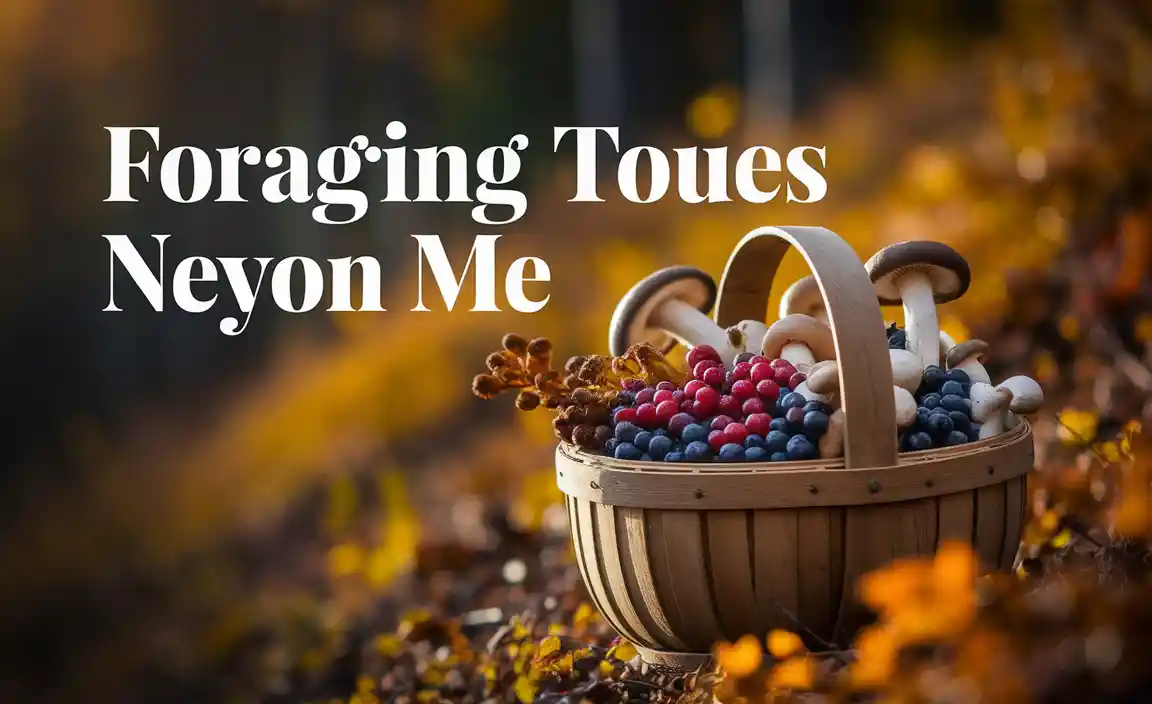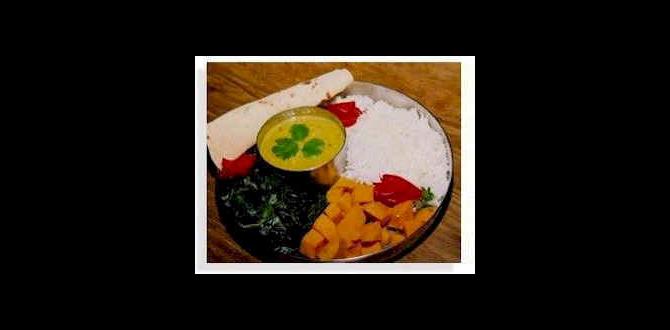Quick Summary:
Looking for “foraging tours near me”? Discover guided nature walks that teach you to safely identify and harvest edible wild plants. It’s a fun, educational, and delicious way to connect with nature and find fresh ingredients right in your backyard.
Ever wanted to taste wild berries straight from the bush or find fresh herbs growing freely? Foraging can be an exciting adventure, but knowing what’s safe to eat is super important. Jumping into foraging without guidance can feel a bit overwhelming, and you might worry about picking the wrong thing. That’s where foraging tours come in! They are your friendly guides to the natural world, showing you the delicious secrets hidden all around us. Get ready to explore, learn, and safely discover edible treasures. We’ll walk you through everything you need to know.

Why Embark on a Foraging Tour?
Foraging is more than just finding free food; it’s a journey back in time and a way to deeply connect with the environment. Think of it as a treasure hunt where the prize is fresh, flavorful ingredients you can use in your kitchen. Plus, it’s a fantastic way to get some fresh air and exercise!
Here’s why joining a foraging tour is a brilliant idea, especially when you’re just starting out:
- Safety First: This is the biggest reason! Expert guides teach you to distinguish between edible and poisonous plants, a skill that’s absolutely crucial.
- Learn from the Best: Experienced foragers share their knowledge, shortcuts, and secret spots. You’ll learn identification tricks you wouldn’t find in a book.
- Discover Local Delights: Tours focus on what’s growing in your specific region, introducing you to local edible plants you might have overlooked.
- Sustainable Practices: Learn how to harvest plants responsibly, ensuring that you don’t harm the ecosystem and that these plants can regrow for future generations.
- Connect with Nature: It’s a mindful activity that encourages you to slow down, observe, and appreciate the natural world around you.
- Expand Your Culinary Horizons: Discover unique flavors and ingredients to bring back to your kitchen and impress your friends and family with your new skills!
Finding Foraging Tours Near You: Your Essential Checklist
Ready to find a foraging adventure? Here’s how to search smart and find the perfect tour:
1. Online Search Power
The easiest way to start is with a good old internet search. Use specific terms to get the best results:
- “Foraging tours [Your City/Region]”
- “Wild food walks [Your State]”
- “Edible plant identification classes near me”
- “Local foraging expert [Your Area]”
Look beyond the first few results. Sometimes smaller, local groups don’t rank as high but offer incredible experiences.
2. Local Nature Centers and Parks
Your local nature centers, botanical gardens, and state/national parks are fantastic resources. They often host educational programs, including:
- Guided nature walks
- Seasonal plant identification workshops
- Volunteer opportunities focused on habitat restoration (which often involves learning about plants!)
Check their event calendars regularly or give them a call. These organizations are committed to environmental education and may partner with experienced local foragers.
3. Foraging Organizations and Societies
Many regions have dedicated foraging or wild food societies. These groups are passionate about wild edibles and often organize:
- Meetups
- Workshops
- Guided forages
These can be goldmines for finding knowledgeable guides and like-minded individuals. A quick search for “[Your State] Wild Food Society” or “[Your Region] Mycological Society” (for mushroom forages) might turn up great options.
4. Social Media and Community Groups
Platforms like Facebook are great for local community groups. Search for foraging, wild food, or permaculture groups in your area. Members often share information about upcoming tours, workshops, and foraging events.
5. Local Farmers’ Markets
Sometimes, local foragers sell their sustainably harvested goods at farmers’ markets. They might also be willing to share information about tours or classes they conduct. Strike up a conversation – you never know what you might learn!
What to Expect on a Foraging Tour
So, you’ve found a tour! What’s the experience actually like? Foraging tours are typically hands-on and educational events led by an expert.
Here’s a general breakdown of what you can anticipate:
- Meet Your Guide: You’ll usually meet at a predetermined spot, often a park, forest trailhead, or nature preserve. The guide will introduce themselves and briefly discuss the focus of the tour (e.g., spring greens, summer berries, autumn mushrooms).
- Safety Briefing: Before you even start walking, your guide will emphasize safety rules. This includes crucial information on avoiding poisonous look-alikes, learning the “universal edibility test” (though usually advised against for beginners in favor of positive identification), and understanding ethical harvesting.
- The Walk and Learn: The group will then embark on a walk. The guide will point out various plants, explaining their identification characteristics. You’ll learn about edible wild plants, medicinal herbs, and potentially some common ‘weeds’ you might have in your garden. They’ll discuss the best times to harvest, which parts of the plant are edible (leaves, roots, flowers, fruits), and how to prepare them.
- Hands-On Practice: You’ll likely have opportunities to touch, smell, and possibly taste (under strict guidance) different plants. You might even get to practice harvesting under supervision.
- Q&A: Throughout the tour, there will be ample time for questions. Don’t be shy! This is your chance to clarify any doubts.
- Wrap-up and Resources: Most tours conclude with a summary of what you learned. Guides often provide resources like recommended books, websites, or even their contact information for future questions. Some tours might include a small tasting session with previously foraged ingredients or a recipe suggestion.
Essential Gear for Your Foraging Adventure
You don’t need a lot of fancy equipment to start foraging, but a few key items will make your experience much more enjoyable and safe.
Here’s a list of what to bring:
- Comfortable Footwear: Sturdy, closed-toe shoes or hiking boots are a must, especially if you’ll be walking on uneven terrain.
- Weather-Appropriate Clothing: Layers are your friend! Bring a waterproof jacket, long pants (to protect from scratches and insects), and a hat.
- Reusable Bag or Basket: For carrying any ethically harvested goodies. Avoid plastic bags, as they don’t allow airflow and can damage delicate greens. Woven baskets are traditional and breathable.
- Knife or Scissors: A small, sharp knife or sturdy scissors are useful for cutting stems or roots.
- Field Guide: While your guide is the primary source of information, having a reliable field guide for your specific region can be a great reference and learning tool. Make sure it covers edible plants and has clear photographs or illustrations.
- Water and Snacks: Stay hydrated and energized, especially on longer tours.
- Insect Repellent: Depending on the season and location, bugs can be a nuisance.
- Sunscreen: Protect your skin even on cloudy days.
- Notebook and Pen: To jot down plant names, key identification features, or preparation tips.
Types of Foraging Tours
Foraging tours aren’t one-size-fits-all. Depending on your interests and location, you might find specialized tours:
General Edible Plant Walks
These are the most common types of tours. They cover a broad range of edible plants found in a particular habitat, like forests, meadows, or coastal areas. You’ll learn to identify berries, greens, roots, and possibly edible flowers.
Mushroom Foraging Tours (Mycology Walks)
These tours are specifically for finding edible mushrooms. Mushroom identification is particularly tricky and requires expert knowledge due to the presence of deadly toxic species. Always go with a qualified mycologist. These are often seasonal, typically occurring in the spring and fall.
Herb and Medicinal Plant Walks
Focus on plants with medicinal properties and those commonly used in culinary dishes for flavor. You’ll learn about their traditional uses and how to prepare them for teas, tinctures, or seasonings.
Coastal or Shoreline Foraging
If you live near the coast, you might find tours focused on edible seaweeds, shellfish (with proper safety regulations), or coastal plants. Regulations for harvesting from public waters can be strict.
Urban Foraging Tours
Yes, you can forage in the city! These tours explore parks, vacant lots, and green spaces within urban areas, revealing the edible plants that thrive even in developed environments. They often highlight the resilience of nature.
Safety and Ethical Considerations: The Golden Rules of Foraging
Foraging is incredibly rewarding, but it comes with significant responsibilities. Safety and ethics are paramount. Your foraging tour guide will emphasize these points, but it’s good to be aware from the start.
The Golden Rule: Positive Identification
Never, ever eat any wild plant unless you are 100% certain of its identification. This is where a guided tour is invaluable. Rely on credible field guides and experienced mentors. If there’s any doubt, leave it. It’s better to err on the side of caution.
A common misconception is the “universal edibility test.” While it exists, it’s a complex and risky process best left to survival experts, not for casual foraging. Foraging tours teach you positive identification of specific edible species.
Beware of Look-Alikes
Many edible plants have toxic or unpalatable look-alikes. For example, wild onions can be mistaken for toxic bulbs, and some mushrooms resemble safe varieties. Your guide will teach you the distinguishing features.
Know Your Location
Be mindful of where you are foraging. Avoid areas that may be contaminated with pesticides, herbicides, heavy metals from industrial runoff, or pet waste. This is especially true for urban foraging. Foraging near busy roads or in areas treated for weed control is generally not recommended. Look for pristine natural areas.
Harvest Responsibly
Always practice sustainable harvesting. This means:
- Take only what you need. Leave plenty for wildlife and for the plant to reproduce.
- Know the plant’s life cycle. Don’t harvest roots if it kills the plant, unless you have permission and are practicing sustainable harvesting techniques.
- Vary your harvest locations. Don’t deplete a single patch.
- Check local regulations. Some plants are protected, and foraging may be restricted in certain areas or require permits. The U.S. Forest Service often has information on foraging in national forests.
Respect Private Property
Always ensure you have permission before foraging on private land. Trespassing can lead to legal trouble and harm your reputation as a responsible forager.
Allergies and Sensitivities
Even if a plant is generally recognized as edible, you could have an individual allergy or sensitivity. Start with small quantities of any new wild food when you first try it at home.
Preparing Your Foraged Finds
Once you’ve safely and ethically brought your treasures home, the culinary adventure continues! Remember to always wash your foraged items thoroughly, just as you would any produce from the grocery store.
Foraging Tour Guide Recommendations
Your tour guide is the best source for preparation tips! They know the plants best and can offer specific advice on:
- Which parts of the plant are best to eat.
- How to prepare them (e.g., raw, cooked, dried).
- Flavor profiles and what they pair well with.
- Simple recipes to get you started.
General Preparation Tips for Common Finds
Here’s a peek at how some common wild edibles might be best enjoyed:
| Foraged Item | Edible Parts | Preparation Ideas | Notes |
|---|---|---|---|
| Dandelion Greens | Leaves, Roots, Flowers | Young leaves can be eaten raw in salads (bitter, so pair with sweet dressings); mature leaves are great sautéed with garlic; roots can be roasted or brewed into tea; flowers can be made into wine or fritters. | Best harvested before flowering for leaves. |
| Wild Berries (e.g., Blackberries, Raspberries) | Fruit | Eaten fresh, in pies, jams, smoothies, or sauces. | Ensure positive identification. Many cultivated berries have wild counterparts. |
| Purslane | Leaves, Stems | Succulent and slightly tart, can be eaten raw in salads, sandwiches, or lightly cooked. | Often found in gardens and disturbed soil. |
| Wild Garlic/Ramps | Leaves, Bulbs, Stems | Use like garlic or onion – in pesto, pasta dishes, soups, or sautéed. | Harvest sustainably; only take a few leaves or bulbs from a large patch. Some areas have regulations. |
| Chickweed | Leaves, Stems, Flowers | Mild, fresh flavor. Can be added to salads, sandwiches, or used as a garnish. | Easy to identify, grows low to the ground. |
Remember that foraging isn’t just about finding food; it’s about understanding the plant’s natural cycle and how it fits into the ecosystem. Recipes can adapt, but respecting the plant and its environment is the most important first step.
Frequently Asked Questions About Foraging Tours
Q1: What is the best way to find foraging tours near me?
The best way is a combination of online searching using specific keywords like “foraging tours [your city]” and checking with local nature centers, parks, and wild food organizations. Social media groups can also be helpful.
Q2: Do I need any prior experience to join a foraging tour?
No! Foraging tours are perfect for beginners. They are designed to teach you the basics safely and effectively. The guides are there to share their expertise.
Q3: What should I wear on a foraging tour?
Wear comfortable, weather-appropriate clothing, including long pants and sturdy, closed-toe shoes. Layers are a good idea, and bring a hat and rain gear if needed.
Q4: Is it safe to eat wild plants?
It can be, but only if you are absolutely certain of positive identification and have learned safe harvesting practices. Guided tours are essential for beginners to learn how to avoid poisonous plants.
Q5: Can I bring my children on a foraging tour?
Many foraging tours welcome children, but it’s always best to check with the tour organizer beforehand. Children often find foraging to be a fun and educational outdoor activity.
Q6: What if I want to forage on my own after the tour?
A tour is a great start! However, continue to use reliable field guides specific to your region, practice your identification skills on common plants, and always prioritize safety and ethical harvesting. If in doubt, don’t eat it.
Q7: How much does a foraging tour typically cost?
Prices can vary widely depending on the length of the tour, the expertise of the guide, and the location. You might find free walks offered by parks or non-profits, while specialized workshops could range from $30 to $100 or more per person.
A Deeper Connection to Your Food and Environment
Embarking on a foraging tour is more than just learning to find edible plants; it’s about opening your senses to the world around you. You’ll start to notice the subtle changes in the seasons, the specific calls of birds, and the intricate details of plants you once walked by without a second glance. This connection fosters a deeper appreciation for nature and a more mindful approach to the food we consume.
By joining a guided tour, you gain the confidence and knowledge to explore safely. You’ll discover that the natural world is a larder full of delicious possibilities, all while learning the vital importance of sustainability and respect for the environment. So, the next time you’re looking for an adventure, consider searching for “foraging tours near me.” You might just uncover a new passion and a whole new way of experiencing the landscape, turning your local parks and forests into vibrant, edible classrooms.


